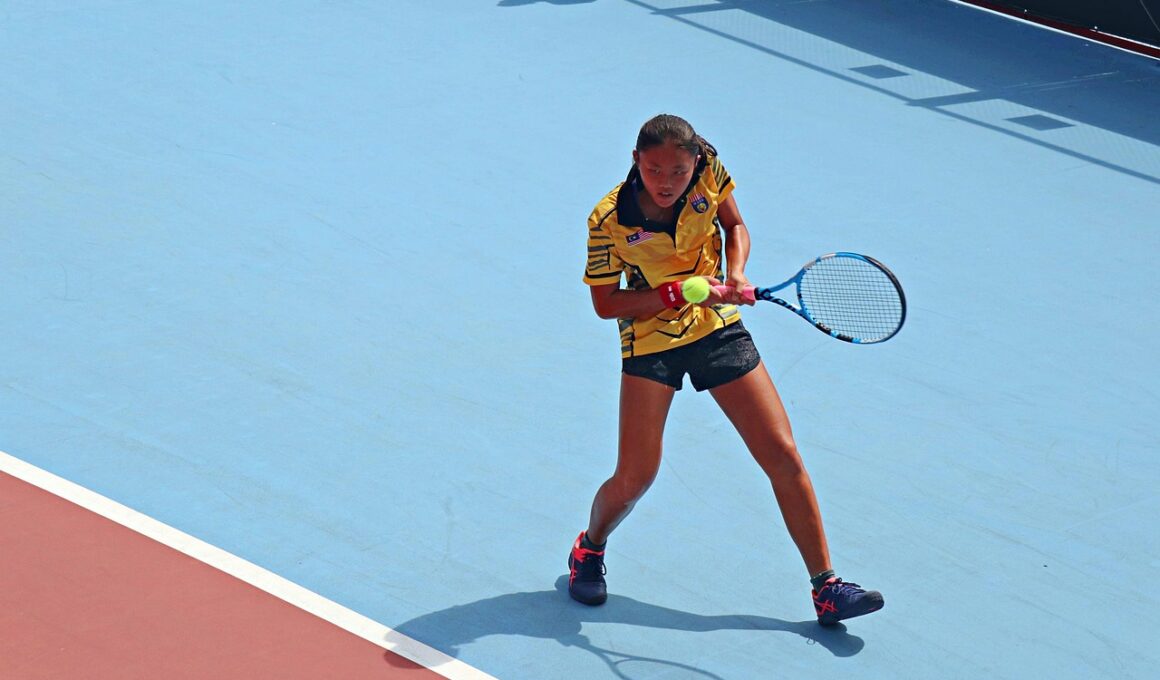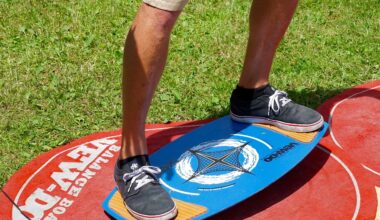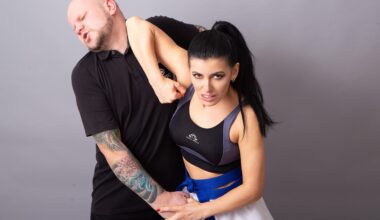Enhancing Coordination in Teens Through Plyometric Workouts
Plyometric workouts represent an exciting opportunity for enhancing coordination among teens. These exercises encourage rapid and explosive movements that engage multiple muscle groups, making them ideal for improving athleticism. By incorporating plyometric training, teenagers can enhance their motor skills, balance, and overall body control. Greater coordination is essential for a variety of sports, including basketball, soccer, and gymnastics. Plyometric exercises like jump squats and box jumps require precision and control, which translates to better performance in athletic competitions. Additionally, these workouts aid in developing the neuromuscular connections vital for executing complex movements effectively. In established routines, teamwork-oriented plyometric drills can foster collaboration among peers, building camaraderie and social skills as well. Teens can also experience increased confidence through their progress, leading to a more positive self-image. Furthermore, plyometric training helps in enhancing endurance and flexibility. All these benefits contribute to a well-rounded athletic capability, allowing teens to tackle sports with enhanced agility and strength. For best results, these workouts must be appropriately supervised and gradually increased in difficulty to suit the individual teen’s fitness levels, which promotes safe practice.
Plyometric exercises for teens can be both engaging and beneficial for overall athletic development. These movements are not just about jumps; they consist of various forms, including likes of hops, bounds, and depth jumps. These workouts can help strengthen muscles and improve cardiovascular endurance while being fun and dynamic. For example, incorporating activities such as medicine ball throws or hurdle hops into routines delivers a comprehensive workout while keeping participants motivated. Additionally, using agility ladders or cones during drills leads to improved foot speed and movement mechanics. Such diversity in training engages different muscle groups and aspects of physical fitness, encouraging consistent participation. Proper warm-up sessions should precede plyometric training to minimize injury risks. Warm-ups can include light aerobic exercises and specific mobility drills targeting the lower limbs. After workouts, adequate cooldown exercises are equally important to prevent muscle stiffness and promote recovery. Teens might also enjoy group sessions where they can motivate each other. Regular feedback during these sessions informs teens about their progress, helping them set and achieve fitness goals. Overall, a balanced approach to plyometric training can yield exceptional coordination benefits for adolescents.
The Importance of Proper Technique
Proper technique in plyometric exercises is crucial for effective training and injury prevention. Without the right form, the risk of strains or sprains increases significantly, particularly for growing adolescents. Coaches and trainers should ensure that teens learn exercises like squat jumps or lateral hops with proper mechanics to maximize safety. Emphasizing the use of soft landings and explosive take-offs protects joints and promotes muscle efficiency. Consistent feedback and correction should be provided during sessions, as many young athletes may lack awareness of their form. For instance, focusing on landing softly with bent knees can prevent impact injuries and create a better training experience. Video analysis may help in assessing youth performance, allowing focused adjustments to their techniques. As teens progress, introducing feedback tools or demonstrating advanced plyometric variations can stimulate learning. However, safety must remain a priority. Establishing a well-rounded warm-up routine consisting of dynamic stretches and mobility drills can help prepare the body for high-intensity movements. Moreover, ensuring proper footwear offers necessary support during plyometric sessions. Enhancing coordination through proper technique ultimately leads to improved self-confidence and interest in further physical activities.
A fluid approach to plyometric training can significantly enhance coordination in teenagers. When these workouts foster both fun and challenge, teens engage more willingly. Incorporating varied equipment into training sessions can keep motivation high and help develop different physical skills. Videos demonstrating unique plyometric exercises can be shared for added inspiration, showing how to use a variety of equipment creatively. Furthermore, engaging social components such as team competitions or group challenges promotes enthusiasm for workouts. Involving friends in training sessions can also provide incentives through friendly competition, enhancing camaraderie. As motivation grows, teens will likely remain committed to achieving better fitness and coordination levels. Talking regularly about personal goals will help keep teens accountable and aware of their progress. Parents or coaches may consider setting up regular assessments to track improvements, which make goals tangible and attainable. A culture of achievement flourishes in environments where regular feedback is shared. Moreover, ensuring teens receive recognition and praise for their efforts can boost their motivation and desire to continue training. By maintaining a balanced and stimulating approach to plyometric workouts, teens can develop impressive coordination and strength as they progress in their fitness journeys.
Plyometric Drills to Enhance Coordination
Several effective plyometric drills specifically target coordination in teens. Exercises like box jumps, lateral bounds, and tuck jumps work on lower body coordination, allowing teens to learn precise body control. For box jumps, selecting appropriately sized boxes can provide an excellent opportunity to practice jumping techniques safely. Lateral bounds, or side-to-side jumps, promote lateral agility, necessary for sports performance. Integrating a rest frame between sets can encourage the recovery needed to maintain high-intensity output, making these exercises effective. Additionally, agility drills with a focus on quick foot movement often include quick step-ups or directional changing exercises, optimizing agility while improving coordination. Building a circuit that alternates between upper- and lower-body plyometric exercises can create a balanced training session focused on strength and coordination. The incorporation of team-oriented challenges or timed trial exercises can create a fun atmosphere while fostering competitiveness. Furthermore, proper hydration practices will contribute significantly to workout efficacy and recovery. Providing educational insights about hydration can further enhance the understanding of overall wellness. In conclusion, exploring a variety of dynamic and challenging plyometric drills can elevate coordination in young athletes.
To reinforce the impact of plyometric training on coordination, it’s vital to highlight the importance of consistency. Teens benefit maximally from regular plyometric sessions that are thoughtfully structured within their fitness regimes. Developing a structured weekly calendar featuring plyometric exercises fosters familiarity with various movements while progressively scaling challenges. Ideally, sessions should occur two to three times weekly to ensure muscle adaptation without excessive fatigue. Discussions about the role of rest days and recovery will also help teens understand how to balance workouts and improve performance effectively. Additionally, tracking improvements and setting tangible goals can create excitement around participation. Teen engagement may also be reinforced by incorporating fun challenges and competitions. Organizing events with other teams or classes promotes a higher level of excitement while showcasing achieved skills. Personal records from activities like jump height or distance can also help motivation. Furthermore, building a culture of support among peers cultivates a love for physical activity that can last into adulthood. It connects to a broader understanding of why regular exercise matters, nurtures friendships, and encourages all teens to remain active and engaged in promoting teamwork.
Conclusion: A Path to Better Coordination
In conclusion, plyometric workouts offer substantial potential for boosting coordination in teens. By fostering an enjoyable atmosphere, these workouts create pathways toward improved physical performance across various sports. Building coordination in adolescents prepares them for tasks requiring greater agility and strength. The incorporation of proper technique in sessions emphasizes safety, ensuring that young athletes harness maximum benefits without falling victim to injury. Teens are likely to develop a positive attitude toward fitness by participating consistently and setting measurable goals. Careful attention to their progress and recognition of efforts encourages self-esteem throughout the training journey. Peer engagement during workouts, supportive competition, and a structured framework help maintain enthusiasm and participation. Moreover, the importance of hydration, proper recovery, and injury prevention cannot be underestimated in ensuring longevity in their athletic pursuits. Overall, plyometrics not only enhance physical capacity but also instill personal growth in young athletes. Enhanced coordination, agility, and confidence benefit all aspects of life, inspiring teens to remain active as they grow into adulthood. In a world increasingly reliant on technology, fostering an active lifestyle profoundly impacts future generations.
Plyometric training is a fun and effective way to enhance athletic skills in teens. Engaging in these dynamic workouts can improve not only strength but also coordination across various sports disciplines. With the right approach and guidance, teenagers can safely explore the world of plyometrics while reaping the rewards of improved performance and physical fitness.


